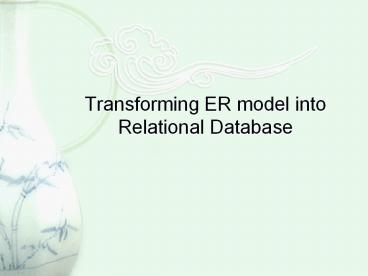Transforming ER model into Relational Database PowerPoint PPT Presentation
1 / 17
Title: Transforming ER model into Relational Database
1
Transforming ER model into Relational Database
2
Step 1
- Make relation schemes with the attributes of each
entity sets - Excluding weak entity sets and multi-valued
attributes.
3
Example of step 1
- student(student, name, address, major,
earned_credits)
Earned_credits
Student
address
major
name
student
4
Step 2
- Make a relation scheme with the primary key of
strong entity set and attributes of weak entity
set - The primary key of the relation scheme is (the
primary key of strong entity set) (the
determinant of weak entity set)
5
Example of step 2
- Dependent_family(emp, name, relationship,
birthday, sex, occupation)
6
Step 3
- Transformation of 11 relationship set
- When the relationship set has partial
participation P and total participation T, insert
the primary key of entity set with P into the
relation scheme with T. - When the relationship has same participation
(partial or total), any direction of insertion of
the related primary key is OK. - Reason all entities belonging to T are affected
by the relationship, so that we can avoid NULL
values in the corresponding fields, if otherwise
inserted.
7
Example of step 3
- employee(emp, name, entered date)
- department(dept, dept_name, location)
- ? department(dept, dept_name, location, emp)
Dept_name
location
Dept
Emp
1
1
employee
department
manage
8
Example of step 3(cont.)
- Whats meaning of emp in department(dept,
dept_name, location, emp) ? - question
- Whats problem, if we insert the primary key of
entity set with total participation into relation
scheme of partial participation? - employee(emp, name, entered date,dept)
- Whats meaning of dept here?
9
Step 4
- Transformation of 1N relationship set
- Append the primary key of entity set at
1-relationship to the relation scheme at
N-relationship - (ex)
- customer(cust, name, , telephone), and
- order(order, payment_method, order_date)
- One customer can order many times?1N
relationship - order(order, payment_method, order_date, cust)
10
Example of step 4
- For relation schemes
- customer(cust, name, , telephone), and
- order(order, payment_method, order_date)
- How about if we attach order to relation scheme
customer(i.e., attach Many-sides P.K. to
1-sides) ? - ? customer(cust, name, , telephone, order)
- Whats the problem?
11
Step 5
- Transformation of NM relationship
- Make a new relation scheme with primary keys of
related entity sets. - Include the attributes of the relationship into
the new relation scheme.
12
Example of step 5
- Order(order, payment_method, order_date)
- Product(product, product_name, assortment,
standard, unit_price, total_stock) - ?Order_product(order, product,
ordered_quantity) - See the next slide for an example ERD
13
Example of step 5(cont.)
- Order(order, payment_method, order_date)
- Product(product, product_name, assortment,
standard, unit_price, total_stock) - ? Order_product(order, product,
ordered_quantity)
N
M
Order
Product
Ordered_quantity
14
Step 6
- Make a new relation scheme with multi-valued
attribute and the primary key of the entity set - (ex)
- employee(emp, name, address, hobbies)
- ? employee(emp, name, address),
employee_hobby(emp, hobby)
15
Step 7
- Works for multiple(gt2) relationship
- Make a new relation scheme with the primary keys
of related entity sets. - (ex) register(student, course, professor)
- See the next slide for an example ERD
16
Example of step 7
- Make a new relation scheme with the primary keys
of related entity sets. - (ex) register(student, course, professor)
Course
course
Professor
Student
register
student
professor
17
Transformation of IS-A relationship
- Make a relation scheme for upper entity set
- For the lower entity sets, make relation schemes
with - (the primary key of upper entity set)
- (the attributes of lower entity sets)
- (ex)
- Upper entity set
- Employee(emp, name, address, entered_date)
- Lower entity sets
- Temporary_worker(emp, daily_allowance)
- Regular_worker(emp, salary)
- Contract_worker(emp, daily_allowance, contract)

